Camping is an exhilarating way to connect with nature, but staying clean in the wilderness can be a challenge. Good camping hygiene is more than a luxury—it’s essential for preventing health issues like rashes, infections, or wildlife encounters. As avid campers with years of experience exploring national parks and remote backcountry, we’ve honed practical strategies for personal hygiene while camping.
This guide draws on our expertise, tested in places like Yosemite and the Appalachian Trail, to share camping hygiene essentials, eco-friendly hacks, and proven methods to keep you fresh. Whether you’re a first-time camper or a seasoned adventurer, these tips will ensure a cleaner, safer trip. Ready to master how to stay clean while camping? Let’s dive in!
Just a heads up! This post contains some affiliate links, which means I might earn a small commission at no additional cost to you. Thanks in advance for your support!
TO THE POINT:
Stay clean when camping by packing essentials like biodegradable soap, toothpaste, and a toothbrush. Choose a campsite near clean water, use biodegradable wet wipes, and wear quick-drying clothes. Dispose of waste properly, consider dry shampoo, and camp away from water sources. Portable showers help, keep nails short, and stay hydrated.
Why Camping Hygiene Matters
Maintaining camping hygiene is critical for health, comfort, and environmental stewardship. Poor hygiene can lead to bacterial infections, skin irritations, or even attract wildlife like bears due to food or body odors. According to the Centers for Disease Control and Prevention (CDC), improper sanitation in outdoor settings increases the risk of illnesses like campylobacteriosis.
Our experience camping in bear-heavy regions like Yellowstone taught us that a clean campsite reduces wildlife risks significantly. Beyond health, good hygiene boosts morale—there’s nothing like a refreshing wash after a long hike. By prioritizing hygiene while camping, you protect yourself, your gear, and the environment, aligning with Leave No Trace principles.
Key Benefits:
- Health Protection: Regular handwashing and bathing prevent infections and skin issues.
- Wildlife Safety: Odor-free campsites deter animals, reducing encounters. Learn how to avoid smelly clothes to keep your gear fresh.
- Comfort and Confidence: Staying clean enhances your camping experience, making you feel refreshed.
- Environmental Care: Using biodegradable products minimizes your ecological footprint.
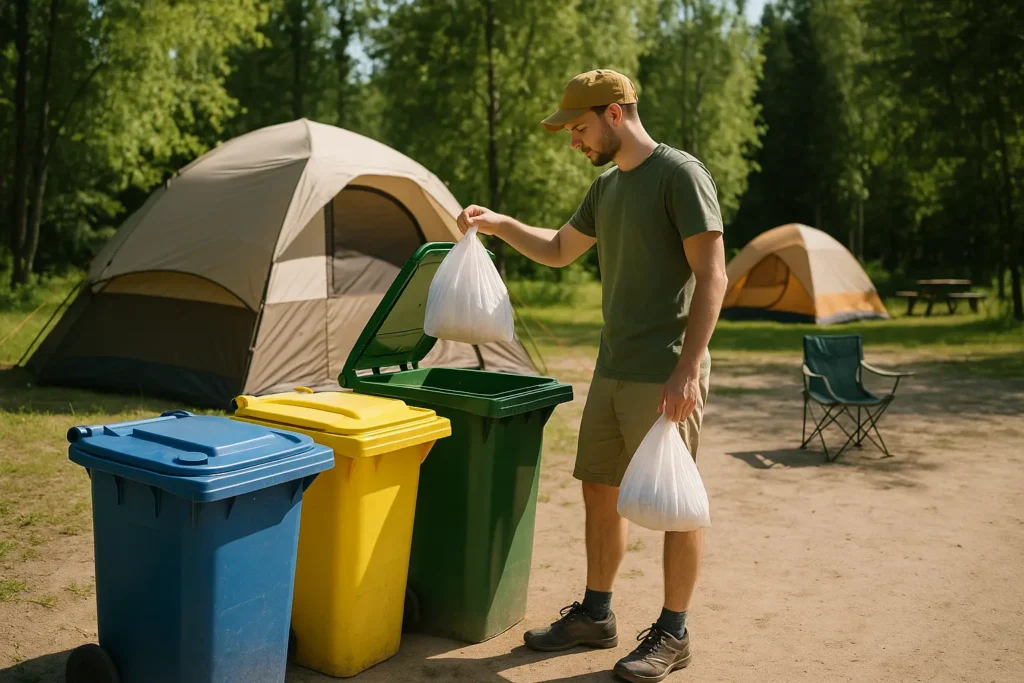
Always pack out all waste, including soap residue, to preserve natural habitats.
Choosing the Right Campsite for Hygiene
Your campsite choice directly impacts camping hygiene. A well-selected site simplifies bathing, dishwashing, and waste disposal. On a recent trip to Great Smoky Mountains National Park, we learned that proximity to clean water and strategic site placement made hygiene tasks seamless. Here’s how to choose wisely:
- Access to Clean Water: Opt for sites near flowing rivers, lakes, or springs. Flowing water is cleaner for bathing and washing dishes. For example, a streamside site in Shenandoah allowed us to rinse gear without contaminating water sources.
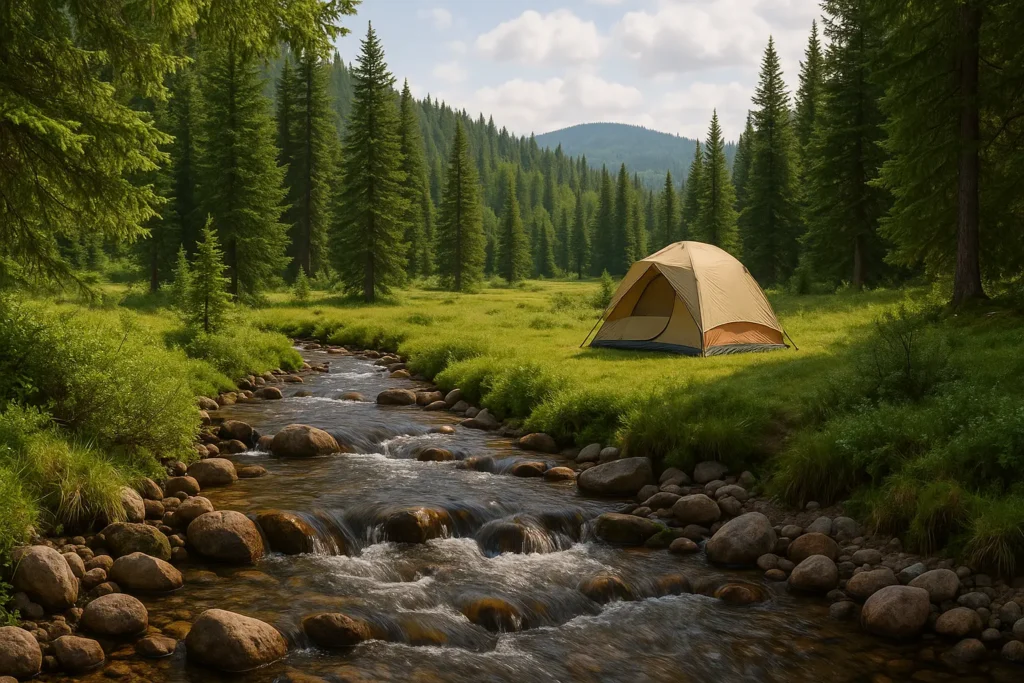
- Distance from Wildlife: Set up at least 200 feet from water sources to avoid attracting insects or animals. Stagnant water harbors mosquitoes, which we encountered at a poorly chosen lakefront site.
- Flat and Stable Terrain: A level site prevents runoff from washing or cooking areas into your sleeping zone, keeping your tent clean. Choose one of the best tents for camping for easy access and cleanliness.
- Privacy Considerations: Choose secluded spots for bathing or changing to maintain comfort and modesty.
Expert Tip: Check park regulations for water use, as some areas restrict soap near streams. Always carry a water filter (e.g., Sawyer Squeeze) for safe drinking water.
Camping Hygiene Essentials: What to Pack
Packing the right camping hygiene essentials ensures you stay fresh without overloading your pack. Our years of backpacking have refined this list to balance utility and weight. Here’s what we always bring, tested on multi-day treks:
- Biodegradable Soap: Products like Dr. Bronner’s All-One Soap are versatile for body, hair, and dishes. We used it on a 5-day Adirondacks trip with no environmental impact. Learn more about choosing the right soap for eco-friendly camping.
- Toothbrush and Toothpaste: Choose biodegradable toothpaste (e.g., Tom’s of Maine) to avoid harming ecosystems. A bamboo toothbrush saves space and is eco-friendly.
- Body Wipes: Biodegradable wipes (e.g., Sea to Summit Wilderness Wipes) are a lifesaver for water-scarce sites. They kept us fresh during a dry desert camp in Joshua Tree.
- Hand Sanitizer: Use alcohol-based sanitizers (60%+ alcohol) for quick germ-killing. We rely on Purell for pre-meal hand cleaning.
- Toilet Paper or Portable Bidet: Biodegradable toilet paper or a portable bidet (e.g., CuloClean) minimizes waste. A bidet saved us pack space on a Pacific Crest Trail section.
- Microfiber Towel: Compact and quick-drying, perfect for sponge baths or showers. We love the PackTowl for its absorbency.
- Nail Clippers: Short nails prevent dirt buildup, reducing infection risk. We learned this after a muddy hike in the Cascades.
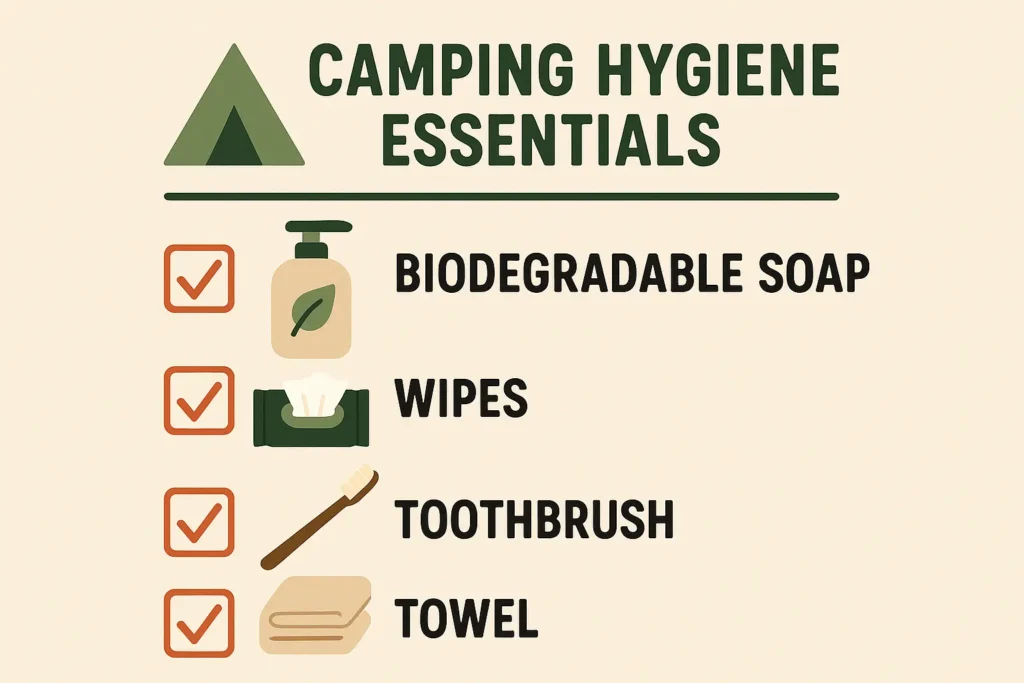
What to Avoid:
- Mirrors: Unnecessary weight; use a reflective surface like a phone screen if needed.
- Deodorants: Scents attract bears and insects, as we discovered in Glacier National Park.
- Non-Biodegradable Products: These harm wildlife and water sources.
Camping Hygiene Essentials vs. Alternatives
| Item | Purpose | Eco-Friendly Alternative | Why We Recommend It |
|---|---|---|---|
| Biodegradable Soap | Body, hair, dishes | Lemon juice + baking soda | Versatile, eco-safe, widely available |
| Body Wipes | Quick clean-up | Sponge with water | Lightweight, effective for waterless sites |
| Toothpaste | Oral hygiene | Baking soda | Biodegradable, reduces environmental harm |
| Hand Sanitizer | Kill germs | Aloe vera + tea tree oil | Natural, effective for sensitive skin |
Stock up on gear! Explore our eco-friendly camping products guide for trusted recommendations.
How to Shower When Camping: 4 Proven Methods
A wilderness shower can be a morale booster, and we’ve tested every method to find what works. From desert camps to alpine lakes, here are four ways to master how to wash when camping:
1. Sponge Bath
What You Need: 1–3 liters of water, biodegradable soap, sponge or washcloth, microfiber towel.
Steps:
- Find a private spot 200 feet from water sources to comply with Leave No Trace.
- Mix soap with water in a collapsible bucket for efficiency.
- Scrub high-sweat areas (armpits, groin, feet) with a soapy sponge.
- Rinse with clean water, using the sponge or splashing sparingly.
Dry with a microfiber towel to avoid damp gear.
Why It Works: Conserves water, ideal for backpackers. We used this method on a water-scarce Grand Canyon hike with great results.
2. Solar Shower
What You Need: Solar shower bag (e.g., Nemo Helio Portable Shower), biodegradable soap, privacy tent or tarp.
Steps:
- Fill the bag with 5–10 liters of water and place it in direct sunlight for 2–3 hours.
- Hang it on a sturdy tree branch or pole above head height.
- Shower with warm water, using soap minimally to protect the environment.
- Pack out any soap residue in a sealable bag.
Why It Works: Feels like a luxury in remote settings. Our team loved it during a week-long trip in the Sierras.

3. Nature Shower
What You Need: Access to a lake, river, or waterfall, biodegradable soap.
Steps:
- Select flowing water for cleaner rinsing, avoiding stagnant ponds.
- Apply soap 200 feet from the water to prevent contamination, as we did at Lake Tahoe.
- Rinse off in the water, keeping soap use to a minimum.
- Dry with a towel and dispose of gray water properly.
Why It Works: Refreshing and immersive, but requires environmental care to avoid pollution.
4. Body Wipes
What You Need: Biodegradable body wipes (e.g., Surviveware).
Steps:
- Wipe high-sweat areas (armpits, groin, feet) for a quick refresh.
- Focus on dirtiest areas to conserve wipes.
- Store used wipes in a sealed trash bag for proper disposal.
Why It Works: Perfect for water-scarce environments, like a recent Death Valley trip where water was limited.
Can I use natural remedies for camping hygiene?
Yes, you can use some natural remedies while camping hygiene. Eco-conscious campers can enhance camping hygiene hacks with natural remedies. Our team has experimented with these alternatives across various climates, ensuring they’re safe and effective:
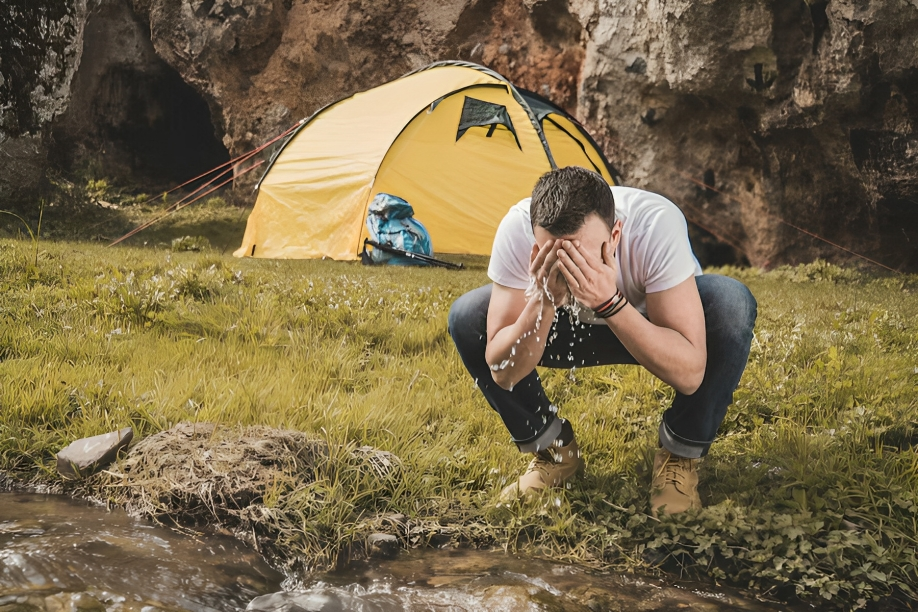
- Lemon Juice: A natural deodorant and stain remover. Dilute with water (1:1 ratio) to avoid skin irritation. We used this on a humid Florida trip to stay odor-free.
- Baking Soda: Mix with water for a toothpaste substitute or sprinkle on hair as dry shampoo. It neutralized foot odor during a week-long Sierra Nevada trek.
- Tea Tree Oil: Dilute with a carrier oil (e.g., coconut oil) for antiseptic wound cleaning or add to homemade hand sanitizer. Its antibacterial properties saved us from a minor cut infection in the Rockies.
- Coconut Oil: Moisturizes skin and serves as a base for insect repellent with citronella or eucalyptus oils. Test on a small patch to avoid allergies.
- Vinegar: Use diluted white vinegar (1:4 ratio) as a foot soak to combat odor or fungal infections. We used this on a humid Everglades trip to prevent athlete’s foot.
- Aloe Vera: Soothes sunburns or skin irritations. Apply fresh gel from a travel-sized tube for instant relief, as we did in Arizona’s desert heat.
- Menstrual Hygiene: Menstrual cups (e.g., DivaCup) or reusable cloth pads are eco-friendly and easy to clean with minimal water. We found cups ideal for multi-day hikes due to their low waste.
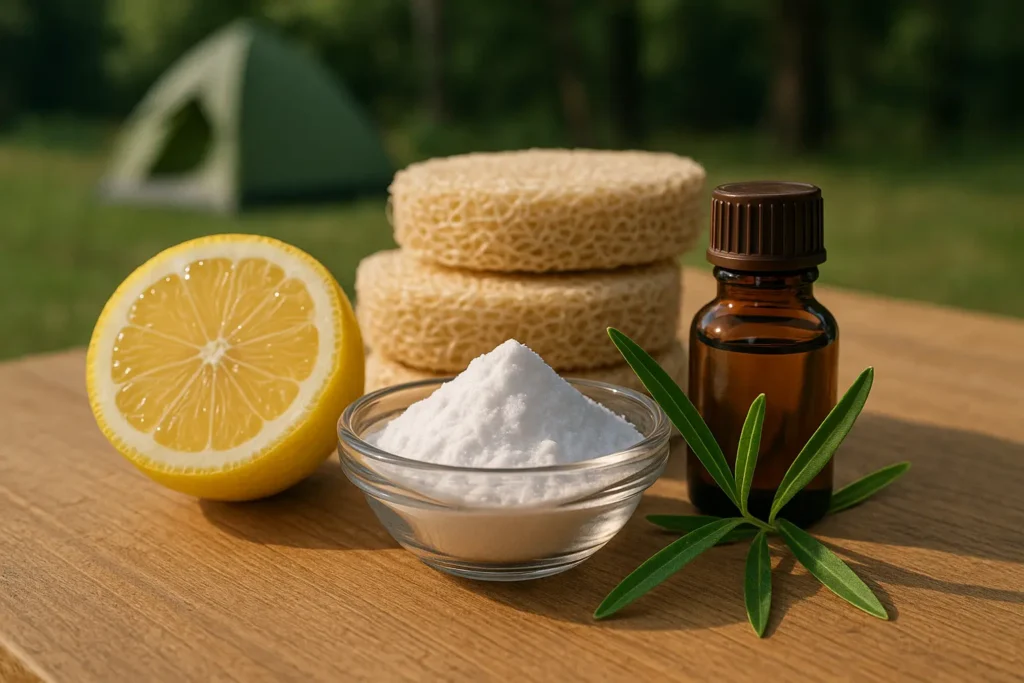
Safety Note: Always test remedies on a small skin patch and research local regulations. The Environmental Protection Agency (EPA) advises against introducing foreign substances into waterways, even natural ones. Learn about safe soap alternatives for eco-conscious camping.
Natural Remedies for Camping Hygiene
| Remedy | Use | How to Apply | Precautions |
|---|---|---|---|
| Lemon Juice | Deodorant, stain remover | Dilute and apply with cloth | Avoid open wounds |
| Baking Soda | Toothpaste, dry shampoo | Mix with water or sprinkle | Use sparingly to avoid drying skin |
| Tea Tree Oil | Antiseptic, sanitizer | Dilute with carrier oil | Patch test for sensitivity |
| Coconut Oil | Moisturizer, repellent base | Apply directly or mix with oils | Check for allergies |
How to Wash Dishes When Camping
Clean dishes are essential for camp hygiene and food safety. Our three-tub system, perfected over years of group camping, makes dishwashing efficient and eco-friendly:
- What You Need: Three portable tubs (or collapsible buckets), biodegradable soap (e.g., Campsuds), sponge or brush, bleach (2 tsp per gallon), strainer, microfiber towel.
- Steps:
- Prep: Boil enough water to fill each tub to cover your largest dish. Use a camp stove for efficiency.
- Wash Tub: Add a squirt of soap to hot water. Soak dishes for 2–3 minutes, then scrub to remove food residue.
- Rinse Tub: Swish dishes in clean hot water to remove soap.
- Sanitize Tub: Soak in water with bleach for 10–15 seconds to kill bacteria.
- Dry: Use a microfiber towel or air-dry on a clean surface to avoid contamination.
- Dispose: Strain food scraps into a sealable trash bag. Dump gray water 200 feet from water sources or in a designated drain, per Leave No Trace guidelines.
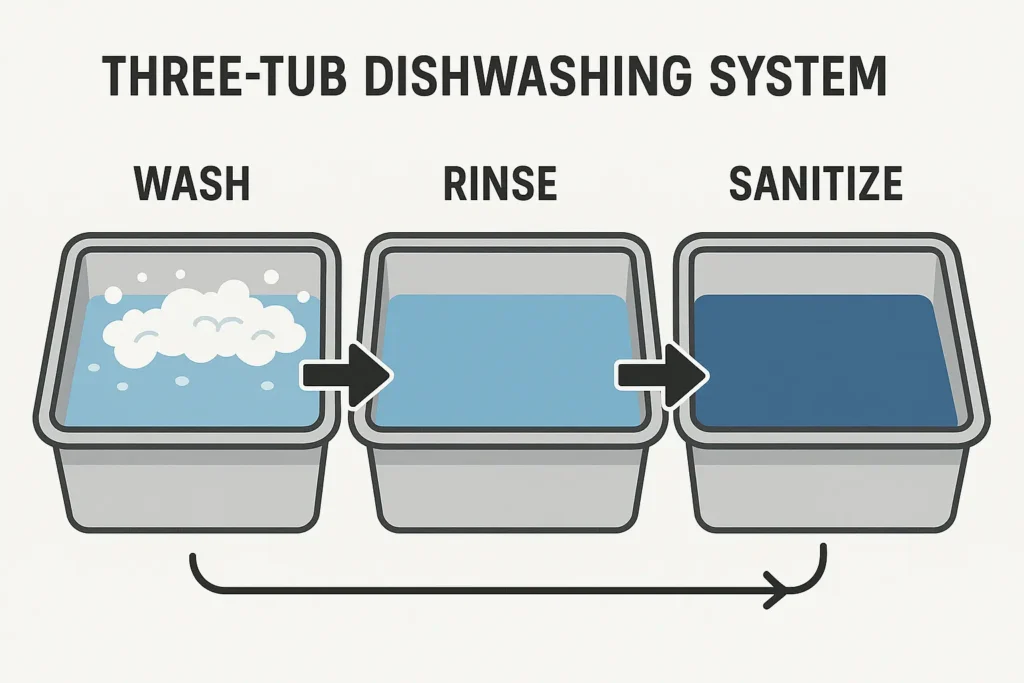
Pro Tip: Scrape food scraps into a compostable bag to reduce waste and prevent wildlife attraction.
Why It Works: This system, used on a 10-person Grand Canyon trip, kept dishes sanitary and minimized water use.
Love a clean camp kitchen? Check our campfire cooking guide and optimize your camp kitchen setup.
Maintaining Hygiene on Long-Term Camping Trips
Maintaining hygiene while camping on multi-day or week-long trips requires planning and adaptability to keep yourself, your gear, and the environment clean. As seasoned backpackers who’ve tackled 10-day treks in places like the Pacific Crest Trail, we’ve learned strategies to stay fresh without access to modern amenities. Here’s how to master personal hygiene while camping for the long haul:
- Rotate Clothing Strategically: Pack moisture-wicking base layers (e.g., Merino wool from Smartwool) and rotate them daily to minimize odor. On a week-long Sierra Nevada trip, we used a lightweight laundry bag to separate dirty clothes, preventing cross-contamination with clean gear.
- Water Management: Carry a high-capacity water filter (e.g., Katadyn Pocket, 50,000-liter lifespan) to ensure a steady supply of clean water for drinking, bathing, and dishwashing. Use collapsible buckets to ration water for sponge baths, conserving resources.
- Odor Control for Gear: Air out your sleeping bag and tent daily to prevent mildew and odors. We sprinkle baking soda inside sleeping bags between uses and use odor-eliminating sprays like Gear Aid Revivex for tents. Store hygiene products in bear-proof canisters, as advised by the National Park Service, to avoid attracting wildlife.
- Sanitation Systems: For human waste, use a trowel to dig cat holes 6–8 inches deep, 200 feet from water sources, per Leave No Trace guidelines. Alternatively, pack a portable toilet (e.g., Cleanwaste Go Anywhere) for high-use areas or strict regulations, like in Yosemite.
- Mental Boost: Hygiene routines boost morale on long trips. A quick wipe-down with biodegradable body wipes (e.g., Surviveware) or a splash of warm water from a solar shower can refresh your mindset after days in the wilderness.
Pack a small mirror (e.g., a compact 2 oz model) for grooming tasks like checking for ticks or cleaning contact lenses, but keep it lightweight to avoid excess bulk.
Preventing Health Risks with Good Hygiene
Poor personal hygiene while camping can lead to health issues that derail your trip. Here’s how we stay safe, backed by expert sources:
- Chafing: Wear moisture-wicking fabrics (e.g., Merino wool) and apply anti-chafing balm (e.g., Body Glide) to thighs or underarms. This saved us on a humid Everglades hike.
- Infections: Clean cuts immediately with antiseptic wipes or tea tree oil. Keep hands sanitized before eating to prevent stomach bugs.
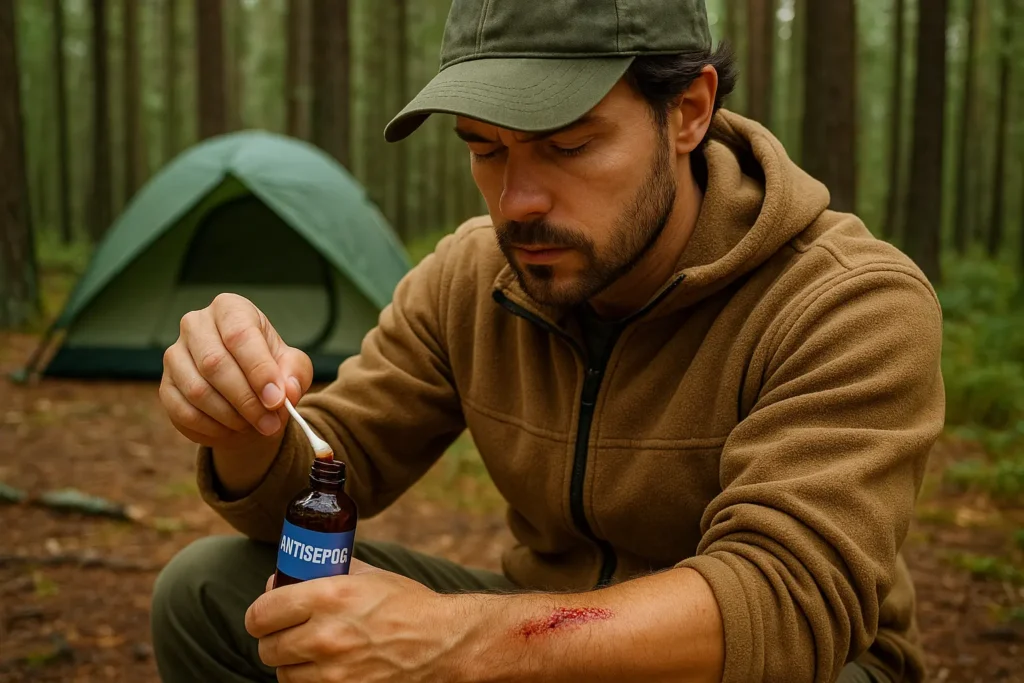
- Ticks and Insects: Use repellents with DEET or natural oils (citronella, eucalyptus). Perform daily tick checks, as recommended by the CDC. We caught a tick early during a Shenandoah trip thanks to routine checks.
- Hydration: Drink 2–3 liters daily using a water filter (e.g., Sawyer Squeeze) or purification tablets to ensure clean water, which supports skin and oral hygiene.
- Diarrheal Illnesses: Reference CDC data (e.g., “Campers face a 10% risk of waterborne illnesses without proper hygiene”) and emphasize boiling water or using purification tablets.
Expert Source: The NPS advises storing hygiene products in bear-proof containers to avoid attracting wildlife.
Hygiene Challenges in Extreme Weather Conditions
Camping in extreme weather—swelteringly hot deserts, freezing alpine nights, or rainy forests—tests your camping hygiene skills. Having camped in conditions from Arizona’s 100°F heat to Montana’s sub-zero winters, we’ve developed strategies to stay clean and healthy no matter the forecast. Here’s how to manage outdoor hygiene in challenging weather:
Hot Weather:
- Sweat Management: Wear breathable, moisture-wicking fabrics (e.g., Columbia’s Omni-Wick) to reduce sweat buildup. On a Mojave Desert trip, we layered with loose-fitting clothes to stay cool and clean.
- Frequent Cleaning: Use biodegradable body wipes or a sponge bath twice daily to remove sweat and prevent rashes. Focus on high-sweat areas like armpits and feet.
- Hydration: Drink 3–4 liters of filtered water daily to support skin health and flush toxins, using a filter like the Sawyer Squeeze.
Cold Weather:
- Layered Hygiene: Keep hands and face clean with alcohol-based sanitizer and a microfiber cloth warmed by a hand warmer. We used this trick during a snowy Yellowstone camp to avoid frostbite while cleaning.
- Dry Cleaning: Use dry shampoo or baking soda to refresh hair without water, as wet hair can freeze. Pack extra socks to keep feet dry and prevent trench foot.
- Warm Water: Heat water on a camp stove for sponge baths to stay comfortable in sub-zero temps.
Rainy Weather:
- Waterproof Gear: Store hygiene products in waterproof bags (e.g., Sea to Summit Ultra-Sil) to keep them dry. A wet trip in Olympic National Park taught us to double-bag toiletries.
- Mud Control: Set up a tarp under your tent vestibule to create a clean changing area. Use quick-drying shoes to avoid tracking mud.
- Drying Solutions: Pack an extra microfiber towel to dry off after rain exposure, preventing skin irritation.
The American Hiking Society recommends prioritizing hygiene in extreme weather to prevent hypothermia or heat-related illnesses.
Check weather forecasts via apps like AccuWeather and pack weather-specific hygiene gear, such as extra wipes for humid conditions or hand warmers for cold.
Sustainable Camping Hygiene
Sustainable camping hygiene ensures you stay clean while preserving the wilderness for future adventurers. As eco-conscious campers who’ve followed Leave No Trace principles across national parks like Glacier and Shenandoah, we’ve honed practices that minimize environmental impact. Here’s how to maintain camp hygiene responsibly:
- Choose Biodegradable Products: Use soaps, shampoos, and wipes certified as biodegradable (e.g., Seventh Generation, Sea to Summit). These break down naturally, reducing harm to soil and water. On a Grand Teton trip, we used Campsuds soap, which left no residue in streams.
- Conserve Water: Limit water use to 1–2 liters for sponge baths or dishwashing. A collapsible bucket (e.g., Sea to Summit Folding Bucket) helps measure and ration water. We conserved 10 liters over a 3-day Joshua Tree trip using this method.
Proper Waste Disposal:
- Human Waste: Dig cat holes 6–8 inches deep, 200 feet from water sources, or use a portable toilet for high-impact areas. Pack out toilet paper in a sealable bag.
- Gray Water: Strain food scraps from dishwater into a trash bag and disperse gray water over a wide area, 200 feet from water, as per EPA guidelines.
- Eco-Friendly Alternatives: Replace toilet paper with a portable bidet (e.g., Tushy Travel) or natural materials like smooth stones (ensure they’re non-toxic). We tested a bidet bottle in the Adirondacks, reducing waste significantly.
- Pack Out All Trash: Use reusable containers for hygiene products to minimize waste. On a multi-day hike, we carried a dedicated trash bag to ensure nothing was left behind.
Sustainable Hygiene Practices
| Practice | Why It Matters | Recommended Gear | Environmental Benefit |
|---|---|---|---|
| Biodegradable Soap | Prevents water contamination | Dr. Bronner’s, Campsuds | Protects aquatic life |
| Portable Bidet | Reduces toilet paper waste | CuloClean, Tushy Travel | Minimizes landfill waste |
| Water Filter | Ensures clean drinking water | Sawyer Squeeze, Katadyn | Reduces reliance on bottled water |
| Collapsible Bucket | Rations water for cleaning | Sea to Summit Folding Bucket | Conserves natural resources |
The Leave No Trace Center for Outdoor Ethics emphasizes proper waste disposal to protect ecosystems, a principle we’ve followed in every camping trip.
Research campsite regulations (e.g., via NPS websites) to ensure compliance with local environmental rules.
Camping Hygiene: (FAQs)
Takeaways: Master Camping Hygiene Today
Mastering camping hygiene ensures healthier, more comfortable, and eco-friendly adventures. From choosing a clean campsite to using solar showers and biodegradable products, these camping hygiene hacks keep you fresh while protecting nature. Whether you’re a beginner or a seasoned camper, our expert tips—honed through years of outdoor experience—will elevate your next trip.
Ready to camp clean? Share your hygiene tips in the comments, explore our eco-friendly camping gear guide, or subscribe for weekly outdoor tips!
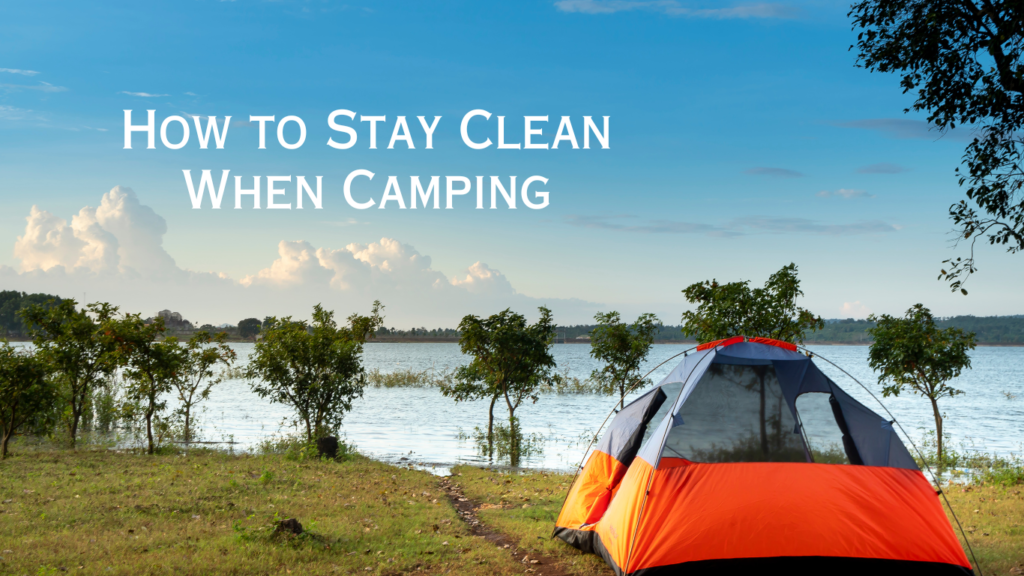
Fantastic perspective! The points you made are thought-provoking. For more information, I found this resource useful: FIND OUT MORE. What do others think about this?